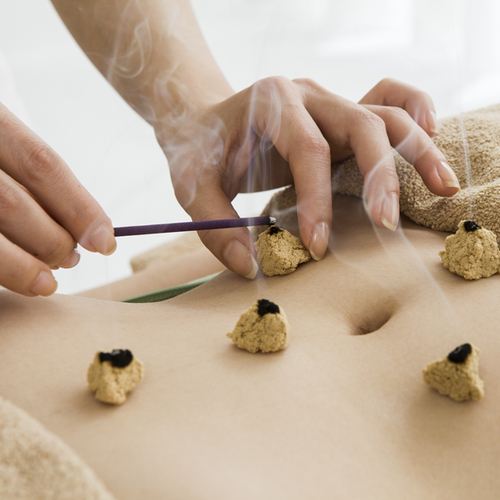
Moxibustion
Alternate names: Aconite Cake-Separated Moxibustion, Acu-Moxi, Acu-Moxibustion, Angelica-Cake Moxibustion, Bird-Pecking Moxibustion, Chinetsukyu (Japanese), Cake-Separated Mild-Warm Moxibustion, Cake-Separated Moxibustion, Circling Moxibustion, Cone Moxibustion, Cotton Sheet Moxibustion, Crude Herb Moxibustion, Direct Cone Moxibustion, Dogbi (ST35) & Sulan Moxibustion, Drug-Separated Moxibustion, Du-Moxibustion, Dynamic Moxibustion, Electric Heating Moxibustion, Electronic Moxibustion, Electrothermal Bian-Stone Moxibustion, Fu-Yang Moxibustion, Garlic Moxibustion, Ginger-Indirect Moxibustion, Ginger-Partitioned Moxibustion, Ginger-Salt-Partitioned Moxibustion, Ginger-Separated Moxibustion, Governor Moxibustion, Grain-Shaped Moxibustion, Hand Moxibustion, Hanging Moxibustion, Heat-Sensitive Moxibustion, Herb-Cake Seperated Moxibustion, Herb-Partitioned Spread Moxibustion, Herbal-Moxa Moxibustion, Indirect Moxibustion, Infrared Laser Moxibustion, Isolated Moxibustion, Isolated-Herbal Moxibustion, Kyutoshin (Japanese), Laser Moxibustion, Long Snake Moxibustion, Medicated Thread Moxibustion, Medicated Threads Moxibustion of Zhuang Nationality, Mild Moxibustion, Mild-Warm Moxibustion, Monkshood Cake-Separated Mild-Warm Moxibustion, Moving Moxibustion, Moxa, Moxa-Cone Moxibustion, Moxa-Stick Moxibustion, Moxibustion Box, Okyu (Japanese), Panlong Moxibustion, Partition-Bran Moxibustion, Partition-Herb Moxibustion, Pecking Moxibustion, Rice-Sized Direct Moxa, Snake Moxibustion, Solar-Term Moxibustion, Sparrow-Pecking Moxibustion, Substance-Partitioned Moxibustion, Suspended Moxibustion, Thin Cotton Moxibustion, Thunder-Fire Moxibustion, Tortoise-Shell Moxibustion, Traditional Box Moxibustion, Warm-Needle Moxibustion, Warming Moxibustion, Warming Needle Moxibustion, Warming-Cup Moxibustion, Zhuang Medicated Thread Moxibustion
Actions: Analgesic, Anti-aging, Anti-diabetic, Anti-inflammatory, Blood flow, Bone, Cardiovascular, Exercise performance, Gastrointestinal, Immune, Neurological
Background
Moxibustion is a type of Traditional Chinese Medicine (TCM). It involves burning the herb mugwort above the skin or on specific points called acupoints.
Moxibustion is an ancient Chinese therapy thought to support the qi or "life force" of the body. There are various types of moxibustion techniques. Most techniques seem to change the temperature and blood flow around the treatment area. This might help the body make chemicals that reduce swelling and pain.
People use moxibustion for hay fever, back pain, osteoarthritis, cancer, acne, HIV/AIDS, aging, and many other purposes, but there is no good scientific evidence to support most of these uses.
Moxibustion is an ancient Chinese therapy thought to support the qi or "life force" of the body. There are various types of moxibustion techniques. Most techniques seem to change the temperature and blood flow around the treatment area. This might help the body make chemicals that reduce swelling and pain.
People use moxibustion for hay fever, back pain, osteoarthritis, cancer, acne, HIV/AIDS, aging, and many other purposes, but there is no good scientific evidence to support most of these uses.
Safety Safety definitions
Moxibustion is possibly safe when administered by a qualified practitioner. It's usually well-tolerated. Side effects might include itching, rash, dizziness, and fatigue.
Breast-feeding There isn't enough reliable information to know if moxibustion is safe to use when breast-feeding. But there's no reason to expect safety concerns when used correctly.
Asthma: Some people with asthma find that the smoke from moxibustion makes breathing more difficult. Talk to your healthcare provider if you have asthma and are considering moxibustion.
Special Precautions & Warnings:
Pregnancy Moxibustion is possibly unsafe when used during pregnancy. It's been linked with premature birth and other serious side effects.Breast-feeding There isn't enough reliable information to know if moxibustion is safe to use when breast-feeding. But there's no reason to expect safety concerns when used correctly.
Asthma: Some people with asthma find that the smoke from moxibustion makes breathing more difficult. Talk to your healthcare provider if you have asthma and are considering moxibustion.
Effectiveness
NatMed Pro rates effectiveness based on scientific evidence according to the following scale: Effective, Likely Effective, Possibly Effective, Possibly Ineffective, Likely Ineffective, Ineffective, and Insufficient Evidence to Rate.
Possibly effective Effectiveness definitions
- Hay fever. Using moxibustion alone or with acupuncture seems to reduce symptoms of hay fever in some people.
- Back pain. Using moxibustion alone or with other treatments might somewhat reduce back pain.
- Menstrual cramps (dysmenorrhea). Using moxibustion with or without acupuncture reduces pain in some people with painful periods.
- A long-term disorder of the large intestines that causes stomach pain (irritable bowel syndrome or IBS). Moxibustion seems to reduce symptoms of diarrhea in some people with IBS. It's not clear if it helps with constipation related to IBS.
- Osteoarthritis. Moxibustion seems to help reduce pain in people with knee osteoarthritis.
Possibly ineffective Effectiveness definitions
- Cancer. Adding moxibustion to cancer treatments doesn't seem to help treat cancer.
Dosing & administration
Moxibustion is a practice of Traditional Chinese Medicine (TCM). It involves burning a dried preparation of an herb, usually mugwort, just over the skin at certain points on the body. There are several different types of moxibustion, including indirect moxibustion, direct moxibustion, thunder-fire moxibustion, warm needle moxibustion/acupuncture, and electric moxibustion. Talk to your healthcare provider to learn more about how moxibustion is used for specific conditions.
Interactions with pharmaceuticals
It is not known if this treatment interacts with any medicines. Before using this treatment, talk with your health professional if you take any medications.
Interactions with herbs & supplements
There are no known interactions with herbs and supplements.
Interactions with foods
There are no known interactions with foods.
vital.ly has licensed monographs from TRC Healthcare.
This monograph was last reviewed on 30/03/2023 11:00:00 and last updated on 27/12/2021 08:13:30. Monographs are reviewed and/or updated multiple times per month and at least once per year.
Natural Medicines disclaims any responsibility related to medical consequences of using any medical product. Effort is made to ensure that the information contained in this monograph is accurate at the time it was published. Consumers and medical professionals who consult this monograph are cautioned that any medical or product related decision is the sole responsibility of the consumer and/or the health care professional. A legal License Agreement sets limitations on downloading, storing, or printing content from this Database. No reproduction of this monograph or any content from this Database is permitted without written permission from the publisher. It is unlawful to download, store, or distribute content from this site.




